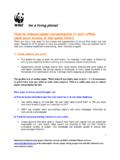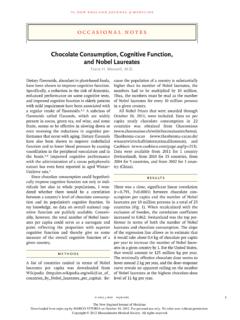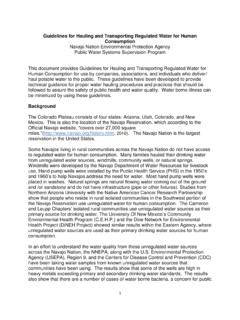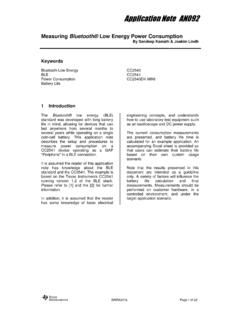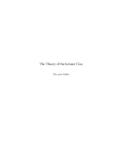Transcription of Author's personal copy - geosimulation.cn
1 This article appeared in a journal published by Elsevier. The attachedcopy is furnished to the author for internal non-commercial researchand education use, including for instruction at the authors institutionand sharing with uses, including reproduction and distribution, or selling orlicensing copies, or posting to personal , institutional or third partywebsites are most cases authors are permitted to post their version of thearticle ( in Word or Tex form) to their personal website orinstitutional repository. authors requiring further informationregarding Elsevier s archiving and manuscript policies areencouraged to visit: 's personal copyLandscape and Urban Planning102 (2011) 33 42 Contents lists available atScienceDirectLandscape and Urban Planningjournal the relationship between urban forms and energy consumption:A case study in the Pearl River Delta, 2005 2008 Yimin Chena, Xia Lia, , Yong Zhengb, Yanyan Guanc, Xiaoping LiuaaSchool of Geography and Planning, and Guangdong Key Laboratory for Urbanization and Geo-simulation, Sun Yat-sen University, Guangzhou, PR ChinabGuangdong Research Institute of Water Resources and Hydropower, Guangzhou 510610, PR ChinacSchool of Business, Sun Yat-sen University, Guangzhou 510275, PR Chinaarticle infoArticle history:Received 27 September 2010 Received in revised form 3 March 2011 Accepted 12 March 2011 Available online 20 April 2011 Keywords.
2 Urban formsEnergy consumptionLandscape metricsPanel data analysisabstractUrban form, which refers to the spatial configuration of urban land use within a metropolitan area, hasprofound influences on energy consumption of a city. Landscape metrics are frequently used to quantifyurban land use patterns, but there are limited studies reporting the implications of different urban landuse patterns on energy consumption. In this study, we attempt to empirically estimate the relationshipsbetween urban land use patterns and energy consumption. Five cities of the Pearl River Delta (PRD)in south China, namely Guangzhou, Dongguan, Shenzhen, Foshan and Zhongshan, are selected as thestudy areas. PRD is becoming an emerging megalopolis and important manufacturing base in the , the rapid and unregulated urbanization process as well as the extensive and inefficient use ofenergy has caused a series of problems. In this study, remote sensing images during 2005 2008 wereused to reveal the dynamic distribution of urban land use based on land use classification.
3 The urban landuse patterns were then quantified using a set of landscape metrics, which further serve as explanatoryvariables in the estimation. The panel data analysis is implemented to estimate the relationship betweenurban land use patterns and energy consumption. Briefly, it is found that: (1) Urban size is positivelycorrelated with energy consumption; (2) fragmentation/irregularity of urban land use patterns is posi-tively correlated with energy consumption; (3) The dominance of the largest urban patch is negativelycorrelated with energy consumption. 2011 Elsevier All rights IntroductionUrban form refers to the spatial configuration of urban landuse within a metropolitan area (Anderson, 1996). Different urbanforms may give rise to diverse social, ecological, and environmen-tal consequences (Camagni, Gibelli, & Rigamonti, 2002; Holden,2004; Wachs, 1993). Many studies revolve around the topic of sus-tainable urban forms (Breheny, 1992; Frey, 1999; Jabareen, 2006;Williams, Burton, & Jenks, 2000).
4 Some researchers believe thatcompact urban forms (Jenks & Burgess, 2000), characterized by highdensity, mixed land use, pedestrian-oriented habitation and energyefficiency (Chen, Jia, & Lau, 2008), are more desirable for retainingthe sustainability of development (Thomas & Cousins, 1996). There-fore, the compact urban forms become increasingly promoted by Corresponding author at: School of Geography and Planning, Sun Yat-sen Uni-versity, 135 West Xingang Rd., Guangzhou 510275, PR : +86 020 33047500; fax: +86 020 Liu).urban planners. Simulation techniques, such as cellular automata(CA), are adopted by researchers to illustrate the planning scenariosof compact development. For example,Li and Yeh (2000)proposeda constrained CA model to simulate compact urban forms of Dong-guan;Ward, Murray, and Phinn (2003)integrated CA model withspatial optimization to generate the development scenario of highdensity and compact growth in south east Queensland, , there are also evidences that challenge the superiority ofcompact urban and Norland (2005)indicated thatlower energy consumption may be achieved by decentralized con-centration.
5 Whether the compact development policy is applicablefor cities in developing countries like China, which inherently has alarge population and high density, still needs further examination(Chen et al., 2008).One important facet of the debate over sustainable urban formsis the relationship between urban forms and energy influence of urban forms on energy consumption is profound,albeit not dominant (Anderson, 1996). Several aspects of urbanforms can significantly affect urban energy consumption, such asthe relationship between new developments and existing towns,the size, shape and function of new urban development, the mix-ing of land uses, travel patterns (Owens, 1986).Banister, Watson,0169-2046/$ see front matter 2011 Elsevier All rights 's personal copy34Y. Chen et al. / Landscape and Urban Planning102 (2011) 33 42 Fig. of the study Wood (1997)tried to reflect the links between energy use intransport and urban forms, based on six case studies in United King-dom and Netherland.
6 Factors significantly affecting urban energyconsumption were identified, such as density, employment and carownership. But the data involved were coarse and the inconsistencyof variables prevented the comparative analysis of different another empirical study on three cities in Netherland,Dieleman,Dijst, and Burghouwt (2002)found that the dependency of privatecars related to factors of car ownership, household type, abun-dance of public transport and local residential ,Baker, and Steemers (2005)devised several algorithms to reflectthe effects of urban texture on the energy consumption of buildings,using digital elevation models (DEMs).Different from the studies mentioned above, we attempt toempirically estimate the relationship between urban forms andenergy consumption from the perspective of spatial patternsof urban land use. With the advances in remote sensing andgeographical information systems (GIS), extensive studies havedemonstrated the use of landscape metrics to quantify the spatialcharacteristics (Alberti & Waddell, 2000; Luck & Wu, 2002; Seto &Fragkias, 2005; Xie, Yu, Bai, & Xing, 2006) and the change of urbanland use patterns (Dietzel, Oguz, Hemphill, Clarke, & Gazulis, 2005;Herold, Scepan, & Clarke, 2002; Liu et al.)
7 , 2010). Landscape met-rics are also considered very useful in assisting urban Leit o and Ahern (2002)developed a conceptual frame-work for sustainable landscape planning, and the landscape metricswere utilized in order to address the ecological concerns. To ourknowledge, less attention has been paid to the link between urbanlandscape and energy consumption. Especially, such studies havenot been reported for the rapidly growing cities in this study, five cities of the Pearl River Delta (PRD) insouth China, namely Guangzhou, Dongguan, Shenzhen, Foshanand Zhongshan, are selected as the study area. As an emergingmegalopolis, PRD becomes an important economic region and man-ufacturing base in the world. Despite its economic success, therapid and unregulated process of urban growth has resulted in aseries of environmental problems (Li & Yeh, 2004; Seto et al., 2002).Meanwhile, the extensive and inefficient use of energy causes aserious degradation of environment (Fang, Chan, & Yao, 2009; Guoet al.
8 , 2006). This study attempts to reveal the relationship betweenurban land use patterns and energy consumption in PRD. Urbanland use patterns are retrieved from multi-temporal images dur-ing 2005 2008. Afterward the spatial patterns of urban land use arequantified by a set of landscape metrics, which are further taken asthe explanatory variables for energy consumption. The panel dataanalysis is then implemented to estimate the relationship betweenurban land use patterns and energy Study area and The Pearl River DeltaThe Pearl River Delta is situated in the central part of Guangdongprovince in south China. This region is mainly dedicated to agricul-tural production until the economic reform started in 1978. Sincethen the region has attracted large amounts of foreign direct invest-ments (FDI), which is the critical support to the take-off of regionaleconomy. The continuing development of manufacturing plantsand joint ventures demands a large quantity of land.
9 As a result,a lot of land was converted from agricultural use to infrastructure,real property or industrial uses. The unregulated urbanization pro-cess gave rise to a series of problems, the loss of large amountof fertile agricultural land (Li & Yeh, 2004; Seto et al., 2002). Manyresearchers were therefore devoted to developing effective meth-ods for monitoring and quantifying the fast changing landscapes ofthe PRD (Seto & Fragkias, 2005; Sui & Zeng, 2001).The economic growth of the region requires a vast volume ofnatural resources, especially energy. Although the Pearl River Deltaonly occupies 20% of the territory of Guangdong province, it con-sumes 67% of the coal and 85% of the oil that are consumed bythe entire province (Shao, Tang, Zhang, & Li, 2006). Moreover, theefficiency of energy consumption is very low compared with otherdeveloped regions in China (like the Yangtze River Delta), not tomention the industrialized countries like US or Japan (Fang et al.)
10 ,2009). The air quality here seriously deteriorates as a result of suchextensive and inefficient use of energy (Fang et al., 2009; Guo et al.,2006). Thus, substantial efforts should be paid to reduce the energyconsumption and improve the environmental this study, we attempt to analyze the relationship betweenspatial patterns of urban land use and energy consumption. FiveAuthor's personal copyY. Chen et al. / Landscape and Urban Planning102 (2011) 33 4235 Table 1 Population, GDP, the number of cars, the proportion of the secondary industry and the tertiary industry of Dongguan, Foshan, Guangzhou, Shenzhen andZhongshan in 2005and (million) (103bellion yuan) of private cars (million) of the secondary industry (%) of the tertiary industry (%) within this region are selected, including Guangzhou, Shen-zhen, Foshan, Dongguan and Zhongshan (Fig. 1).Table 1lists theselected statistics of these five cities in 2005 and 2008, includingpopulation, GDP, the number of cars, the proportion of the sec-ondary industry and the tertiary industry.


